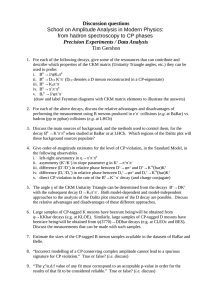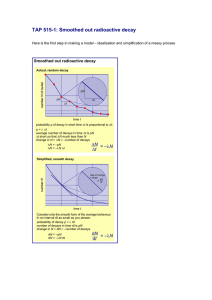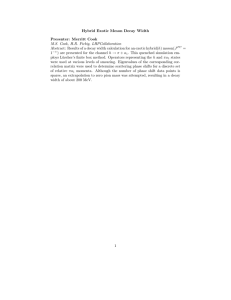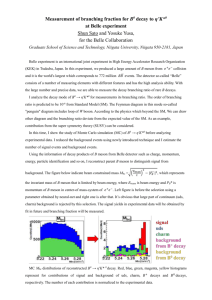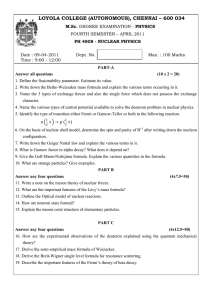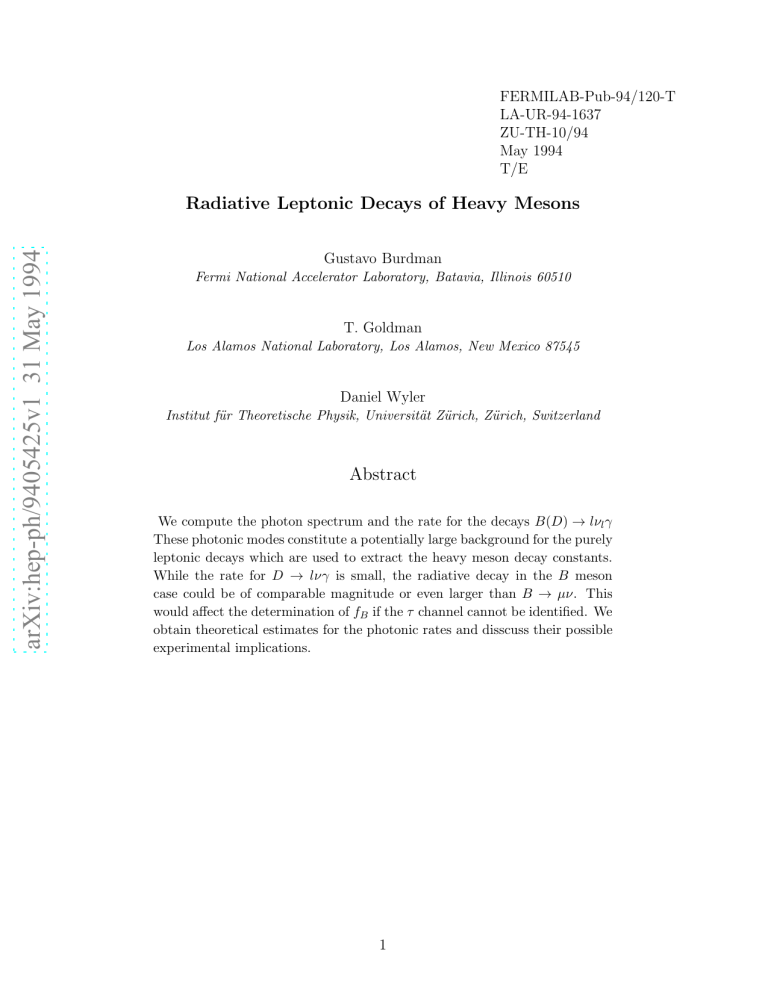
FERMILAB-Pub-94/120-T
LA-UR-94-1637
ZU-TH-10/94
May 1994
T/E
arXiv:hep-ph/9405425v1 31 May 1994
Radiative Leptonic Decays of Heavy Mesons
Gustavo Burdman
Fermi National Accelerator Laboratory, Batavia, Illinois 60510
T. Goldman
Los Alamos National Laboratory, Los Alamos, New Mexico 87545
Daniel Wyler
Institut für Theoretische Physik, Universität Zürich, Zürich, Switzerland
Abstract
We compute the photon spectrum and the rate for the decays B(D) → lνl γ
These photonic modes constitute a potentially large background for the purely
leptonic decays which are used to extract the heavy meson decay constants.
While the rate for D → lνγ is small, the radiative decay in the B meson
case could be of comparable magnitude or even larger than B → µν. This
would affect the determination of fB if the τ channel cannot be identified. We
obtain theoretical estimates for the photonic rates and disscuss their possible
experimental implications.
1
I. INTRODUCTION
The leptonic decays of heavy mesons are of great interest both theoretically and experimentally. The purely leptonic decay B − → l− νl can be used to extract |Vub | by using
predicted values for the B meson decay constant fB from lattice calculations. Or conversely,
if |Vub| is measured in semileptonic decays, the leptonic decay is in principle the only mode
to access fB . On the other hand, the situation in the charmed mesons is clearer given our
knowledge of the CKM mixing angles involved (|Vcs | and |Vcd|). Recently the observation
of the decay Ds → µνµ has been reported [1]. Although the results are still preliminary
it is a first step towards understanding the behavior of heavy meson decay constants. The
experimental difficulty in the measurement of purely leptonic decays of heavy pseudoscalars
is due mostly to the well known effect of helicity suppression: back-to-back leptons must
make a spin 0 final state, but the anti-neutrino is right-handed and forces the charged lepton
to this helicity which introduces a factor of the lepton mass in the amplitude. In the end
the decay rate is suppressed by the factor (ml /mH )2 , where mH is the heavy meson mass.
For instance for the B meson
G2
ml
Γ(B → lν̄l ) = F |Vub |2 fB2
8π
mB
2
m3B
m2
1 − 2l
mB
!
(1)
where the pseudoscalar meson decay constant is defined by
h0|q̄γµ (1 − γ5 )b|B(P )i = ifB Pµ
(2)
and analogous expressions can be written for D mesons. Thus, when the charged lepton is
an electron the purely leptonic decay is practically inaccessible. At the other extreme, when
the charged lepton is a tau there is no suppression. However the observation of this decay
is experimentally difficult (only one visible particle in the final state). Muons seem more
promising to allow the observation of the decay constants of D and B mesons. However in
B → µν the suppression factor is still 4 × 10−4 giving a branching fraction of 10−7 − 10−6 .
There are other decays that indirectly involve the heavy meson decay constants. For
instance, the decay B → πlνl is expected to be largely dominated by a B ∗ pole diagram at
very low recoiling pion energies [2–4]. This implies the presence of the vector-meson decay
constant fB∗ which can be related to fB by Heavy Quark Spin Symmetry [8]. However this
region of phase space is difficult to access due to kinematic suppression.
In this letter we investigate the decay modes B − (D − ) → l− νl γ. There are two types of
contributions: Internal Bremsstrahlung (IB) and Structure Dependent (SD) photon emission
[6]. As is known the IB contributions are still helicity suppressed. On the other hand, the
SD contributions are reduced by the electromagnetic coupling constant α but they are not
suppressed by the charged lepton mass. Therefore, what in principle could be regarded as a
mere radiative correction to the purely leptonic decays has the potential to be of comparable
magnitude and in some cases even much larger. In what follows we analyze the situation in
charmed and beauty mesons. In Sec. 2 we establish the phenomenological relevance of these
decays and in Sec. 3 we discuss theoretical estimates of the unknown constants involved.
Conclusions and comments are presented in Sec. 4.
2
II. PHENOMENOLOGY OF H → µνγ
As mentioned in the previous section, the µ modes are the most interesting from the
point of view of the extraction of heavy meson decay constants. We will concentrate on the
case l = µ but the treatment for l = e is analogous and the numerical differences between
these two cases will be stressed when relevant.
The emission of a real photon in leptonic decays of heavy mesons can proceed via the
two mechanisms mentioned in Sec. I. The possible IB diagrams are shown in Fig. 1. The
corresponding amplitude is given by
MP B = mµ fB ×
(
!
ǫ · pl
ǫ·P
µ̄(1 − γ5 )ν
−F
pl · k
P ·k
1
+
µ̄/ǫ/k (1 − γ5 )ν
2pl · k
)
(3)
where P , pl and k are the four-momenta of the decaying meson, the charged lepton and the
emitted photon, respectively, ǫ is the polarization of the photon and F is the electromagnetic
form-factor of the B meson. (This is not simply related to the Isgur-Wise function [7] given
that the matrix element of the electromagnetic current between two B mesons receives
contributions from both the heavy and light quarks). The important feature of (3) is that it
is suppressed by a factor of the lepton mass, as one would expect of bremsstrahlung photons.
On the other hand, the SD diagrams in Fig. 2 involve the contributions from heavy
intermediate states coupling to the initial heavy pseudoscalar and the photon. In Fig. 2
we show the contributions from vector and axial-vector mesons. The helicity suppression is
avoided because the meson directly coupling to the lepton pair has spin one. These types of
diagrams were previously considered in the context of light pseudoscalar decays, in particular
in π → lνγ and K → lνγ [6]. It was also shown there that this phenomenological picture in
fact correctly accounts for the SD contributions.
The general form of the amplitude corresponding to Fig. 2(a) requires the knowledge of
the B ∗ Bγ coupling. This is defined in the process B ∗ → Bγ with the amplitude given by
A(B ∗ → Bγ) = eµV ǫαβγδ ǫ∗α vβ kγ λδ
(4)
where v is the velocity four-vector of the decaying particle, k is the photon four-momentum,
λ is the polarization four-vector of the B ∗ and µV is a constant characterizing the strength
of the M1 transition. Eqn. (4) can be used to write the amplitude of Fig. 2(a) by having
first the B meson decaying into a real photon and an off-shell vector meson, which after
propagating decays weakly through
h0|q̄γµ (1 − γ5 )b|B ∗ (v, λ)i = ifB∗ ǫµ
(5)
Eqn. (5) defines the vector-meson decay constant. Inserting the heavy vector-meson propagator i(−gµν + vµ vν )/2(v.k + ∆), where ∆ = mB∗ − mB , we obtain its contribution to the
SD diagram
AV (B → µνγ) = eµV
1
fB∗ ǫαβγδ ǫ∗α vβ kγ Lδ
2(v.k + ∆)
3
(6)
with Lδ = ūl γδ (1 − γ5 )vν the lepton current.
There will also be contributions from heavy axial-vector meson states (J P = 1+ ). The
Heavy Quark Symmetries [8] of the strong interactions and their consequences in the hadron
spectrum will help us to identify the relevant contributions. In the Heavy Quark Limit the
spin of the heavy quark decouples from the light degrees of freedom. Thus their total angular
momentum jl can be used as a good label. The meson angular momentum is J = 1/2 ± jl .
For the ground state jl = sl , the spin carried by the light degrees of freedom and therefore
a (0− , 1− ) spin doublet is predicted. This can be identified with the (B, B ∗ ). If we allow for
orbital angular momentum L = 1, then there will be two additional spin doublets as excited
states. They correspond to jl = 1/2 and jl = 3/2 and their parity is even: (0+ , 1+ ) and
(1+ , 2+ ). Thus in principle there could be two different axial-vector mesons contributing to
B → µνγ. We write down the amplitude for the process in Fig. 2(b), which is the generic
contribution of an axial-vector meson intermediate state. The coupling is of the form
(i)
AA (B1 → Bγ) = eµiA (v · kλ · ǫ − v · ǫλ · k)
(7)
where the superscript i = 1/2, 3/2 identifies the spin-parity doublet to which the axial-vector
1/2
3/2
meson belongs. The axial-vector decay constants fA and fA are defined analogously to
fB in (5). Putting these together the contributions of Fig. 2(b) take the form
(i)
(i)
AA (B
eµA fAi
→ µνγ) =
[v · ǫkµ − v · kǫµ ] Lµ
2(v · k + ∆i )
(8)
where ∆1/2 = mB1′ − mB and ∆3/2 = mB1 − mB are the excitation energies of the jl = 1/2
and jl = 3/2 even parity doublets and we again neglected pieces proportional to the charged
lepton mass. It is worth noticing that the axial-vector pseudoscalar mass differences ∆1/2
and ∆3/2 are quantities that remain constant in the limit mQ → ∞ whereas ∆ goes to zero
in the same limit. In the Heavy Quark Effective Theory (HQET) [10] a term that goes as
∆2 can be neglected in the B ∗ propagator on the basis of the heavy mass suppression. In
the case of the B1 or B1′ propagators in Fig. 2(b) the quadratic terms in ∆1/2 and ∆3/2 can
still be considered numerically small even when they are quantities of order 1 in the heavy
masses, when compared with 2mB .
Most importantly, Heavy Quark Spin Symmetry can be used to obtain relations between
the decay constants of particles in the same parity multiplet. For instance
fB∗ = mB fB
(9)
and analogous relations can be written between the decay constants of the members of the
jlP = 1/2+ and the jlP = 3/2+ doublets. However HQS does not predict relations among
decay constants of members of different spin-parity doublets. Then the contributions from
excited states will imply the presence of new unknowns other than the pseudoscalar decay
constant. Defining x = 2Eγ /mB and y = 2El /mB as the rescaled photon and charged lepton
energies in the B rest frame the double differential decay rate is given by
2
dΓ
=
dxdy
G2F |Vub|2
αm3B fB2 ∗ µ2V
2
32π
1
+
2∆
(x + m )2
B
×
X
i
2
γi
i
x + 2∆
mB
1
× y 2 (1 − x) + y(3x − x2 − 2) + (3x2 − 4x − x3 + 2)
2
4
(10)
where we defined
(i)
γi =
µA fAi
µV fB∗
(11)
as the relative axial-vector to vector meson coulping strength. The fact that there are no
relations among decay constants of states of different spin-parity doublets will be reflected
in the persistence of the unknown γi ’s when we normalize to Γ(B → µν). We will analyze
the γi ’s and µV from the theoretical point of view in the next section. For now let us assume
(i)
that µV and µA do not depend on the photon energy so we can integrate and compare with
the purely leptonic decay. The result is
µ
RB
=
=
Γ(B → µνγ)
Γ(B → µν)
1
αµ2 m2
6π V B
mB
mµ
!2
×
Z
0
1
dxx3 (1 − x)
1
2∆
(x + m )2
B
2
X
γi
+
2∆i
i x+ m
(12)
B
To have an idea of the potential importance of the photonic mode we take a definite value
for the mass differences ∆i = 600 MeV as suggested by the charmed meson system [9]. This
gives approximately
µ
RB
≈
2µ2V
(γ1/2 + γ3/2 )2
GeV2
1+
2
!
(13)
which shows that unless there are unnaturally small B photon couplings (see next section)
the photonic decay, which in principle could have been considered a small radiative correction, will dominate the leptonic decay or will be at least of comparable magnitude. Therefore
it is important to have a good theoretical understanding of the couplings of all the relevant
intermediate states in order to substract these events as a background for B → µν. The
fact that, to this order in (mµ /mB )2 , the result of Eqn. (10) is independent of the lepton
mass implies that
Γ(B → eνγ) = Γ(B → µνγ)
(14)
Γ(B → eνγ) ≫ Γ(B → eν)
(15)
and that
allows for the separation of both effects by using the electronic modes as well. Thus integrating (10) over the photon energy and integrating the resulting µ spectrum around the
end point over a region the size of the experimental µ energy resolution in B → µν will
eliminate the background. Perhaps even more interesting, given the richness of the physics
that enters in them, is the possibility of observing the photonic modes at branching ratios
that will soon be accesible (≈ 10−5 − 10−6 ).
The treatement of charmed mesons is entirely analogous to B mesons. With the obvious
replacements in (12) we obtain
5
µ
RD
≈4×
10−2 µ2V
(γ1/2 + γ3/2 )2
GeV2
1+
2
!
(16)
which is suppressed by the factor (mD /mB )4 in rescaling (12). Therefore the effect is, as
expected, less spectacular in the D mesons although of a branching fraction comparable to
that of the effect in the B system.
In the following section we discuss various theoretical estimates of µV and the γi ’s.
III. THEORETICAL ESTIMATES
The radiative leptonic decays depend crucially on the vector and axial-vector couplings
(i)
to the heavy pseudoscalar, µV and µA as well as the ratio of the axial-vector to vector
meson decay constants. The photon couples to both the heavy and light quark pieces of
the electromagnetic current. Heavy Quark Symmetry (HQS) fixes the heavy quark contribution. In the Heavy Quark Effective Theory [10] the coupling of the heavy quark Q to the
electromagnetic field responsible for the B ∗ to B transition is given by the operator
QQ
h̄v σµν hv F µν
2mQ
(17)
where hv is the heavy quark field charaterized by its four-velocity v and QQ is its electromagnetic charge. This leads to
µ(h) =
QQ
mQ
(18)
where the superscript h indicates a contribution from the heavy quark.
The piece of the B ∗ Bγ coming from the coupling to the light degrees of freedom is not
given by HQS. In the SU(3) limit can be written as [13]
µ(l) = Qq β
(19)
where Qq is the charge of the light degrees of freedom and β is an unknown quantity. In the
non-relativistic quark model this is predicted to be
βN RQM = 1/mq
(20)
with mq the constituent light quark mass (mu ≈ md ≈ 330 MeV and ms ≈ 450 MeV). On
more general grounds β is expected to be of the order 1/ΛQCD . If we take the HQS and
the NRQM predictions for µ(h) and µ(l) respectively in order to have an estimate of the
magnitude of the coupling we have the simple expression
µV =
QQ
Qq
+
mQ mq
(21)
which is the naive quark model result but now supplemented by HQS. In the charmed
mesons, it is sufficient to explain the ratio Γ(D ∗0 → D 0 γ)/Γ(D ∗+ → D + γ) [11]. Therefore
6
we will rely on (21) for estimates in the B meson decays. For mb = 5 GeV and taking
β = 3GeV−1 , we see that the value for the coupling
µV ≈ −2GeV −1
(22)
is such that the ratio (12) could be sizeable.
The axial-vector meson couplings are expected
to be of the same order as µV . In fact the
q
√
(1/2)
(3/2)
NRQM gives µA = µV / 3 and µA = 2/3µV , where the superscripts indicate an axialvector meson belonging to the (0+ , 1+ ) and (1+ , 2+ ) doublets repectively. The contributions
of Fig. 2(b) are also proportional to fAi , the axial-vector meson decay constants. But in the
NRQM these are zero given that the wave function at the origin for an orbitally excited
state vanishes due to the presence of a centrifugal barrier. Although this seems to imply
that γi ≪ 1, relativistic effects could be important and modify this prediction drastically.
Unfortunately there is no conclusive experimental indication from other hadronic systems
about the size of the axial-vector meson contributions. In experiments involving π → µνγ
and K → µνγ [9] the ratio of the axial-vector to vector contributions is consistent with zero
and also with being large.
In order to address corrections to this simple picture it is useful to consider an effective
theory coupling heavy hadrons (in this case mesons) to goldstone bosons and also low energy
photons. This theory incorporates both Heavy Quark Symmetry and Chiral Symmetry by
introducing the spin-parity doublet in the form of 4 × 4 matrices as follows [3–5,12]
Ha =
(1 + /v ) ∗
{/
B − Bγ5 }
2
(23a)
Sa =
(1 + /v ) ′
{/
B 1 γ5 − B0∗ }
2
(23b)
(1 + /v ) ∗µν
B γν −
Taµ =
2
2
s
2 ν
1
B1 γ5 (gνµ − γν (g µ − v µ ))
3
3
(23c)
where a = 1, 2, 3 is the SU(3) index of the light degrees of freedom in the hadron. Ha
corresponds to the (0− , 1− ) ground state doublet; Sa is the excited state doublet (0+ , 1+ )
corresponding to the spin of the light degrees of freedom being jl = 1/2 and Taµ is the excited
state doublet (1+ , 2+ ) corresponding to jl = 3/2.
An important set of corrections are those arising from the loop diagrams of Fig. 3, where
the photon couples to a goldstone boson in the loop. This type of correction therefore is not
suppressed by the heavy mass. They were first considered in Ref. [13] for the D ∗ Dγ coupling
in the context of Heavy Hadron Chiral Perturbation Theory (HHChPTh) and introduce a
non-analytic dependence on the quark masses, m1/2
as well as on the mass differences ∆
q
and ∆i that break SU(3) in (19). To calculate these diagrams we need the coupling of two
heavy hadrons to one goldstone boson. These are given by [12]
h
i
h
i
h
L1π = gT r H̄a HbA
/ ba γ5 + g ′ T r S̄a SbA
/ ba γ5 + g ′′T r T̄aµ TµbA
/ ba γ5
h
i
h
+f ′T r S̄a Tbµ Aµba γ5 + f ′′ T r H̄a SbA
/ ba γ5
7
i
i
(24)
with the traces taken over Dirac indices and where the first three terms correspond to the
axial couplings between members of the same spin-parity doublet and the last two terms give
the transitions between doublets. As it was pointed out in [12] the axial couplings between
theh(1+ , 2+ ) doublet
and the ground state vanish to this order in the chiral expansion, that is
i
µ
T r H̄a Tb Aµba γ5 vanishes. This means that the diagrams in Fig. 3 corresponding to having
the (B1 , B2∗ ) inside the loop can be neglected. On the other hand we can also see from (24)
that to this order there will be no B1′ Bπ coupling which prevents a contribution from the
axial-vector meson to the loop. There are four diagrams remaining which correspond to the
heavy mesons in Fig. 3(a) being (from left to right) (B, B ∗ , B ∗ ); (B, B ∗ , B1′ ); (B, B0∗ , B1′ )
and (B, B0∗ , B1 ). In terms of the couplings, the first one corresponds to a correction to µV ,
(1/2)
the two following to a correction to µA
coming from B1′ → Bγ and the last one to a
(3/2)
correction to µA from B1 → Bγ. Finally the diagrams of Fig. 3(b)-(c) vanish in the limit
ml → 0 and will be strongly suppressed. Therefore the only diagrams contributing are the
ones represented in Fig. 3(a), with pion and kaon loops giving
µV =
−1
g2
2
g2
−
+ 2 2 I(mπ , ∆) + 2 2 I(mK , ∆)
3mb 3mq 4π fπ
4π fK
(25)
where
m2
I(m, ∆) = ∆ ln 2 + 2F (m/∆)
µ
with µ the renormalization scale and
( √
√
2 − 1 tanh−1
2
x
√x − 1
√
F (x) =
−1
2
x2 − 1
− x − 1 tan
!
(26)
;x ≤ 1
;x ≥ 1
(27)
(i)
Analogously, the corrections to µA can be computed. With the corrections mentioned
above, the B1′ Bγ coupling is now
(1/2)
µA
1
=√
3
2
−1
−
3mb 3mq
!
(
1
1
+ f ′′ (g ′ − g/2)
I(mπ , ∆1/2 ) + 2 2 I(mK , ∆1/2 )
2
2
4π fπ
4π fK
)
(28)
whereas the B1 Bγ coupling now is
(3/2)
µA
2
=√
3
−1
2
−
3mb 3mq
!
′ ′′
+f f
(
1
1
I(m
,
∆
)
+
I(mK , ∆3/2 )
π
3/2
4π 2 fπ2
4π 2 fK2
)
(29)
The quantities g, g ′ , f ′ and f ′′ are expected to be of order one on dimensional grounds. In
fact the NRQM predicts g = 1. Unfortunately, the D ∗ lifetime has not been measured yet,
preventing the extraction of g from D ∗ → Dπ. The experimental upper limit [15] is g < 0.7.
The model of Ref. [14] predicts g = 0.32. Taking g to be somewhere in between we see that
the magnetic coupling in (25) still remains a quantity of order one or possibly larger. The
same can be said about the corrections to the contributions from axial-vector mesons, where
the corrections do not necessarily reduce the value of the couplings given the different signs
in (28) and (29) as well as the potential relative phases between these strong couplings.
8
So far we have not made a distinction between the contributions coming from the B1′
axial-vector meson, corresponding to jl = 1/2, and the B1 corresponding to jl = 3/2. In
(1/2)
general one can think that their relative contribution is only governed by the size of µA
(3/2)
and µA and their respective decay constants. There is already evidence from the charm
meson system that the (0+ , 1+ ) is very broad relative to the (1+ , 2+ ). This is mostly due to
the fact that the latter does not couple to the ground state to leading order but only through
a D-wave amplitude [12]. Therefore the narrow width approximation implicitly used in the
calculation of (10) should be reconsidered. In principle, we expect a modest suppression of
the B1′ contribution. We have also neglected the possibility of (B1′ , B1 ) mixing which could
be sizable. It has been pointed out in Ref. [12] that in the D meson system this indeed may
occur.
There will be additional corrections coming from terms suppressed by mB and by the
chiral symmetry breaking scale Λχ , which are subleading terms in the heavy mass and chiral
expansions respectively. However we believe that one should not expect these or the one
loop corrections to reduce the value of the couplings significantly, which therefore will remain
of order one or larger. In the case of µV , the B ∗ Bγ coupling, the one loop corrections are
always of the oposite sign. However this is not always true for the µA ’s, where the corrections
could even enhance the value of the coupling considerably.
Perhaps the most important question in terms of the phenomenological impact of these
decays is the approximation made in Sec. II, namely the neglect of the form-factor suppres(i)
sion that affects µV and µA and that would soften the spectrum. This peaks at a photon
energy of ≈ 1.2GeV when the couplings are approximated to be constant. When an energy
suppresion is taking into account the average photon energy would drop typically to a few
µ
hundred MeV. This suppression would result in a smaller value of RB
by a factor that, as
for the shape of the photon spectrum, strongly depends on the energy dependence chosen.
µ
Typical energy dependences would reduce RB
in (12) by a factor of 2 to 4. The first estimate
is obtained with a monopole type suppression whereas the second case corresponds to an
exponential suppression. In both cases the energy scale was chosen to be 1GeV.
On the other hand, we lack an understanding of the axial-vector meson decay constants
and there is a lot of room for theoretical improvements. For the purpose of this letter,
however, it was sufficient to show that a rough estimate of the plausible values of the
relevant couplings suggests that the branching ratio for the photonic decays B → µνγ is
comparable to B → µν and it could be even greater.
IV. CONCLUSIONS
Radiative leptonic decays of heavy mesons are very interesting, not only as a possible
background to purely leptonic decays, but also because they yield new information about the
strong and electromagnetic interactions of heavy hadrons. As expected, they compensate for
their suppression by a factor of α by avoiding helicity suppression. In the charmed mesons,
D and Ds the effect is small for the muon but sizeable for the electron. Allowing for a typical
(i)
form-factor suppression in µV and µA and assuming a large range for the axial-vector decay
constants we have
µ
≈ (1 − 8) × 10−2 µ2V GeV2
RD
9
(30)
which would translate into Br(D → µνγ) ≈ 10−5 .
The situation is very different for the B meson decays. Since the helicity suppression is
so large, we benefit much more by avoiding it; we get
µ
RB
≈ (1 −
4)µ2V
1
1 + (γ1/2 + γ3/2 )2 GeV2
2
(31)
We have seen in Sec. II that the value of µV in the B mesons is likely to remain a quantity
of order one even after considering corrections that might reduce it. This indicates that a
measurement of fB can only be achieved in the decays to muons if the radiative decays are
correctly substracted.
This class of decays clearly deserves further study. In particular it requires knowledge of
the strong couplings g, g ′ , f ′ and f ′′ mentioned above. In any case it seems reasonable to
µ
expect values in the range RB
= (1 − 20). This would translate into
Br(B → lνγ) ≈ (10−7 − 10−6 )
(32)
Therefore the observation of these decays would be of great interest, adding to our under(i)
standing of µV , µA and the decay constants of orbitally excited heavy mesons.
There are in principle several other decays of heavy mesons that proceed via the SD
mechanism. For instance, the decay Bs → µ+ µ− γ will be enhanced over the helicity suppressed Bs → µ+ µ− by an expression similar to (31). In the Standard Model, the latter has
a branching ratio of ≈ 10−9 whereas the radiative decays could be an order of magnitude
greater. In some theories beyond the SM these decays are expected to have larger branching
ratios. For instance, it is argued in Ref. [16] that Extended Technicolor scenarios enhance
Br(Bs → µ+ µ− ) by up to two orders of magnitude, which would imply, together with (31),
Br(Bs → µ+ µ− γ) ≈ 10−7 − 10−6 . This puts this radiative decay within experimental reach
and, together with B → µ+ µ− X [17], can impose severe constraints on physics beyond the
SM.
On the other hand, B → D (∗) γlν and any other exclusive semileptonic decay with a
photon added to the final state can be considered. Similar results may hold for non-leptonic
decays. Although these decays are indeed suppressed by α relative to the corresponding
non-photonic decays, some of them are of interest in their own right and might became
observable in the near future.
ACKNOWLEDGMENTS
The authors thank J.F. Donoghue, A. Falk, Y. Kubota, C. Quigg and M. B. Wise for
useful discussions and suggestions. G.B. and T.G. acknowledge the support of the U.S.
Department of Energy.
10
REFERENCES
[1] M. Witherell, Talk presented at the XVI International Symposium on Lepton-Photon
Interactions, Ithaca New York, August 1993.
[2] N. Isgur and M. B. Wise, Phys. Rev. D41, 151 (1990).
[3] M.B. Wise, Phys. Rev. D45, 2188 (1992).
[4] G. Burdman and J.F. Donoghue, Phys. Lett. B280, 287 (1992).
[5] T. M. Yan, H. Y. Chen, C. Y. Cheung, G. L. Lin, Y. C. Lin and H. L. Yu, Phys. Rev.
D46, 1148 (1992).
[6] T. Goldman and W. J. Wilson, Phys. Rev. D15, 709 (1977), and references therein.
[7] N. Isgur and M. B. Wise, Phys. Lett. B232, 113 (1989); ibid B237, 527 (1990). For a
review see M. Neubert, preprint SLAC-PUB-6263 (1993), to appear in Physics Reports.
[8] N. Isgur and M.B. Wise, Phys. Lett B237, 527 (1990).
[9] Particle Data Group, Phys. Rev. D45, (1990).
[10] H. Georgi, Phys. Lett. B240, 447 (1990);
A. Falk, H. Georgi, B. Grinstein and M. B. Wise, Nucl. Phys. B343, 1 (1990).
[11] CLEO collaboration, F. Butler et al., Phys. Rev. Lett. 69, 2041 (1992).
[12] A. Falk, Phys. Lett. B292, 119 (1992); ibid B305, 268 (1993).
[13] J. F. Amundson, C. G. Boyd, E. Jenkins, M. Luke, A. V. Manohar, J. L. Rosner, M. J.
Savage and M. B. Wise, Phys. Lett. B296, 415 (1992).
[14] W. A. Bardeen and C. T. Hill, Phys. Rev. D49, 409 (1994).
[15] ACCMOR Collaboration, S. Barlag et al., Phys. Lett. B278, 480 (1992).
[16] L. Randall and R. Sundrum, Phys. Lett. B312, 148 (1993).
[17] B. Grinstein, Y. Nir and J. Soares, Phys. Rev. D48, 3960, (1993).
11
FIGURES
Fig. 1: Bremsstrahlung diagrams entering in B → µνγ. The black squares denote the
action of the weak current.
Fig. 2: Structure Dependent diagrams entering in B → µνγ. The black circles denote
(i)
the action of the couplings µV and µA . (a): Vector meson contribution. (b): Axial-Vector
meson contribution.
(i)
Fig. 3: One Loop corrections to µV and µA . Dashed lines denote goldstone bosons while
solid lines denote heavy mesons.
12
This figure "fig1-1.png" is available in "png" format from:
http://arxiv.org/ps/hep-ph/9405425v1
B-
B-
B-
(b)
(a)
Fig. 1
This figure "fig1-2.png" is available in "png" format from:
B-
http://arxiv.org/ps/hep-ph/9405425v1
B-
B*-
(a)
B1
(b)
Fig. 2
